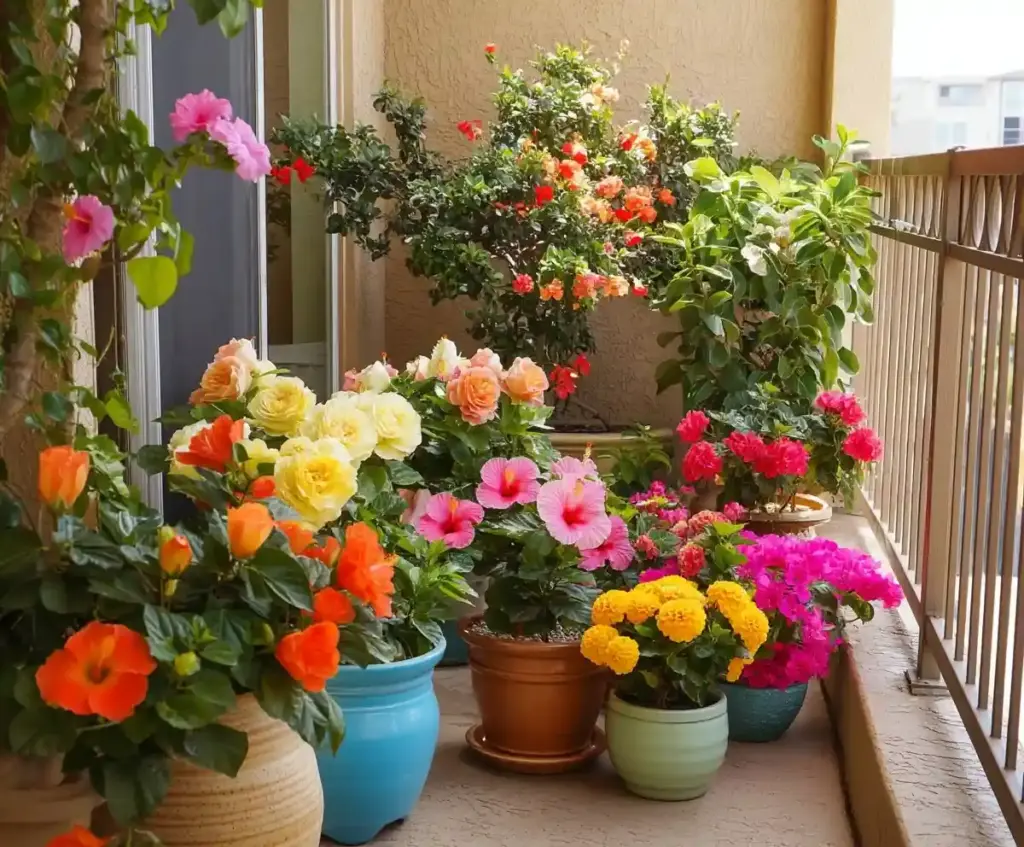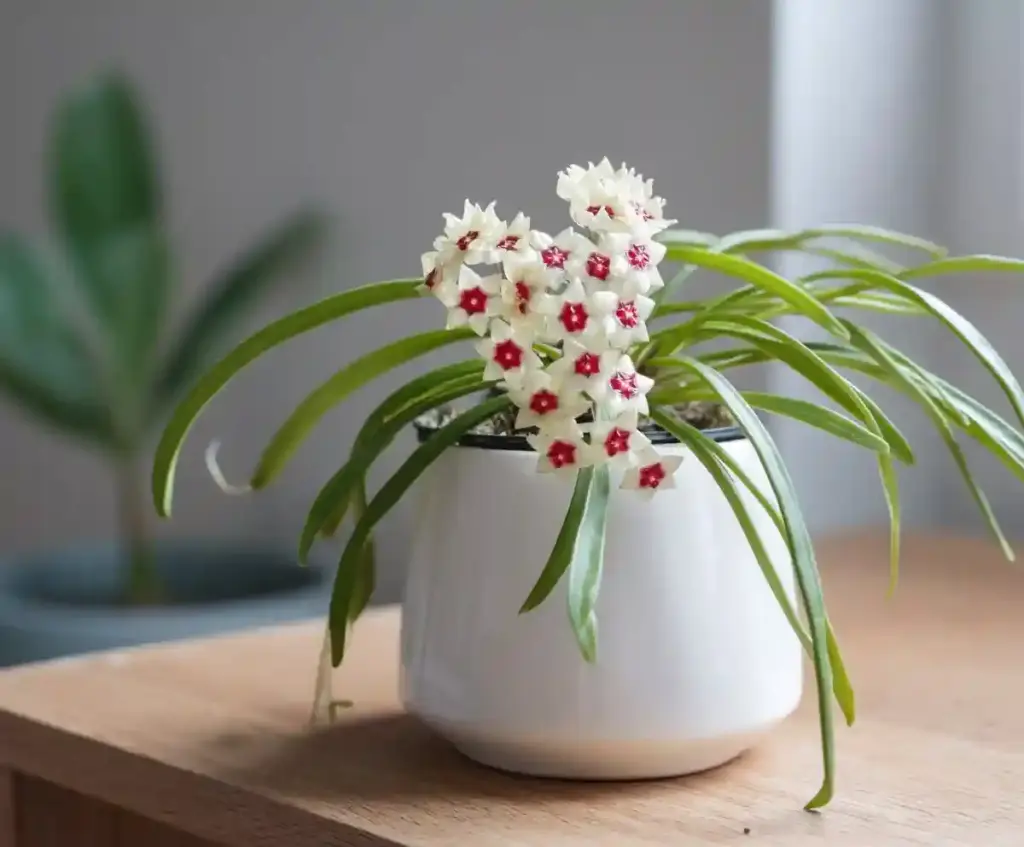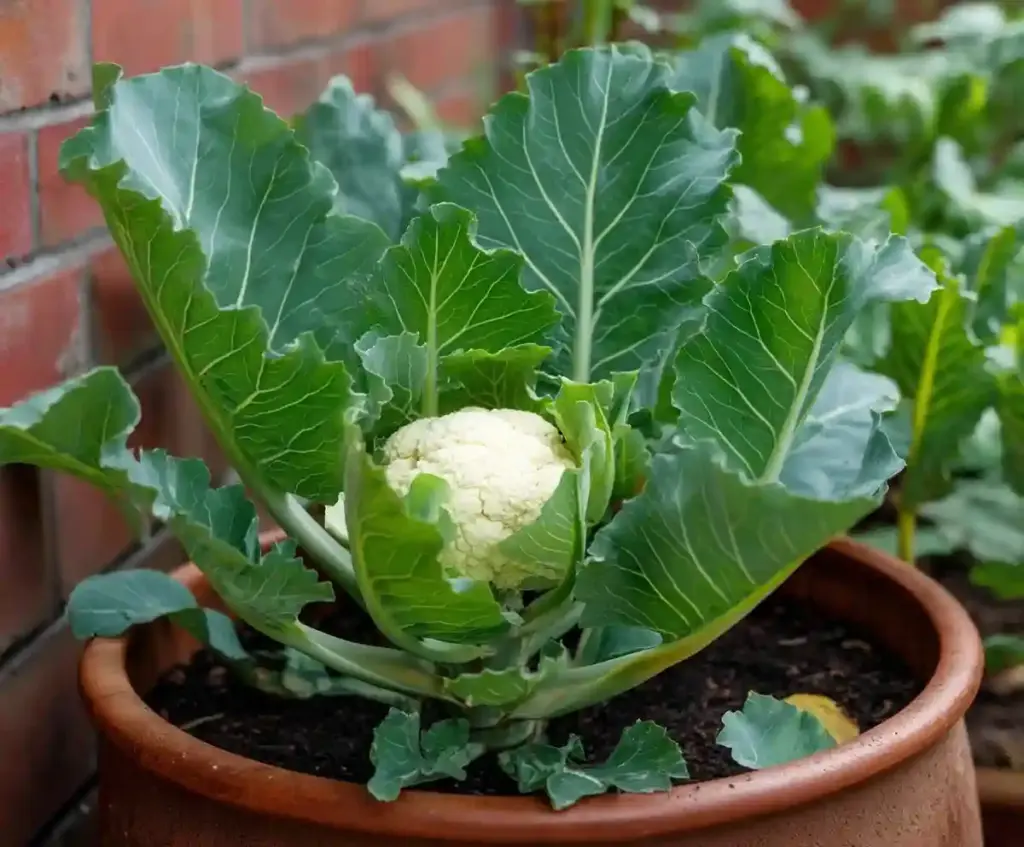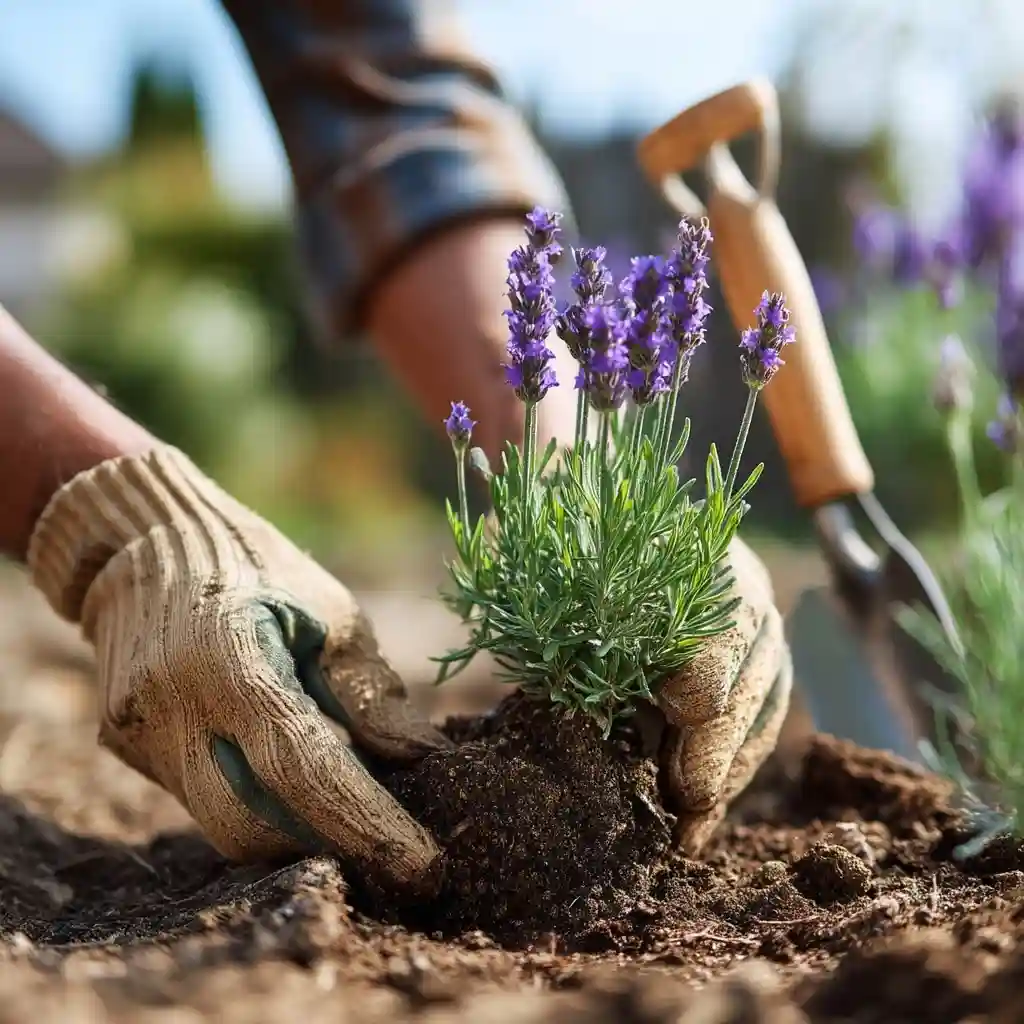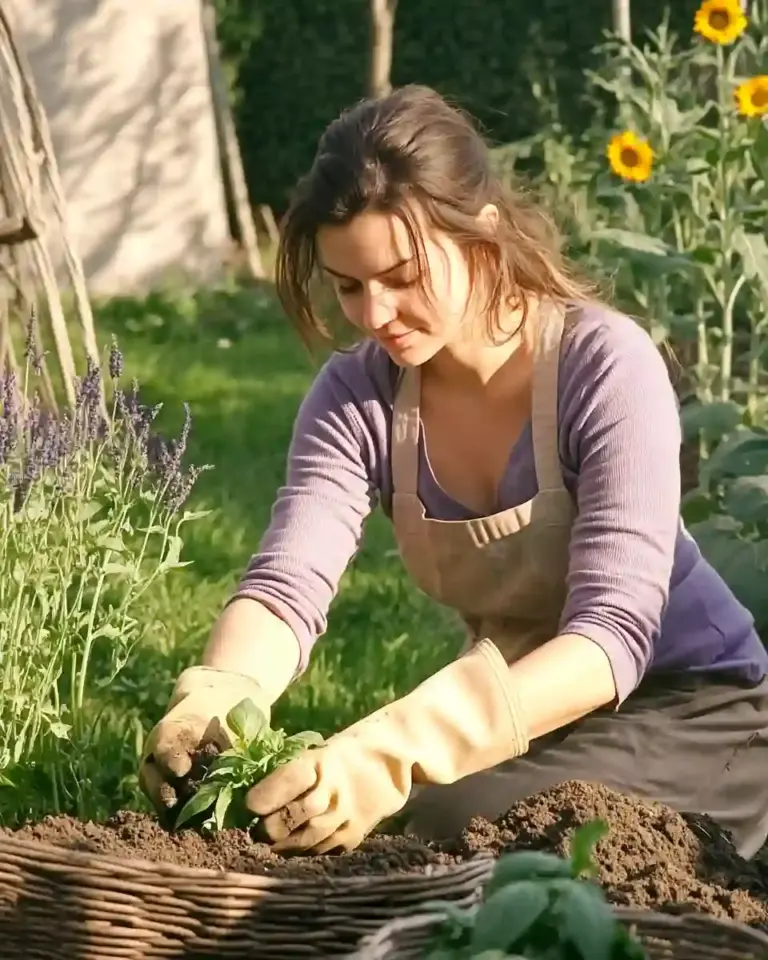How to grow lavender is a question many gardeners ask when looking to add beauty, fragrance, and function to their outdoor space. This hardy, aromatic perennial isn’t just eye-catching—it’s also drought-tolerant, pollinator-friendly, and packed with practical uses.
Whether you’re planting in the ground or containers, growing lavender successfully starts with the right location, proper pruning, and understanding the plant’s unique preferences. From selecting the best variety to handling pests and harvesting blooms, this guide walks you through every step to ensure healthy, thriving lavender plants season after season.
Table of Contents
🌱 Planting
🕒 When to Plant
For gardeners wondering how to grow lavender from the start, timing is everything. The best time to plant lavender is in spring, once the danger of frost has passed and the soil begins to warm—typically in April or May, depending on your region. Planting at the right time allows lavender to establish strong roots before facing summer heat or winter cold.
☀️ Where to Plant
Lavender thrives in locations that receive full sun—at least 6 to 8 hours of direct light daily. Choose a sunny, open space with excellent air circulation to prevent moisture buildup and fungal issues. Avoid planting in low-lying areas where water tends to collect, as poor drainage is the top reason lavender fails to grow well.
🌱 How to Plant Lavender
Whether you’re starting from young plants or seeds, the planting method matters. Here’s how to do it right:
For Transplants:
- Dig a hole twice as wide as the root ball but not deeper than the plant’s current depth.
- Mix in a small amount of compost to improve soil texture.
- Place the plant so the crown sits just above soil level.
- Backfill and water thoroughly to eliminate air pockets.
For Seeds:
- Sow seeds just ⅛ inch deep, barely covering them with soil.
- Keep them spaced at least 2 inches apart, thinning later so mature plants have 6 to 12 inches between them.
- Germination can take 2–4 weeks, so patience is key.
🪨 Soil Preparation Tips
- Lavender prefers well-draining, sandy or loamy soils with a slightly alkaline pH (6.5–7.5).
- If your soil is heavy clay, amend it with coarse sand or gravel to improve drainage.
- Consider raised beds or mounds in poorly draining areas to keep the roots dry and happy.
🌿 Care
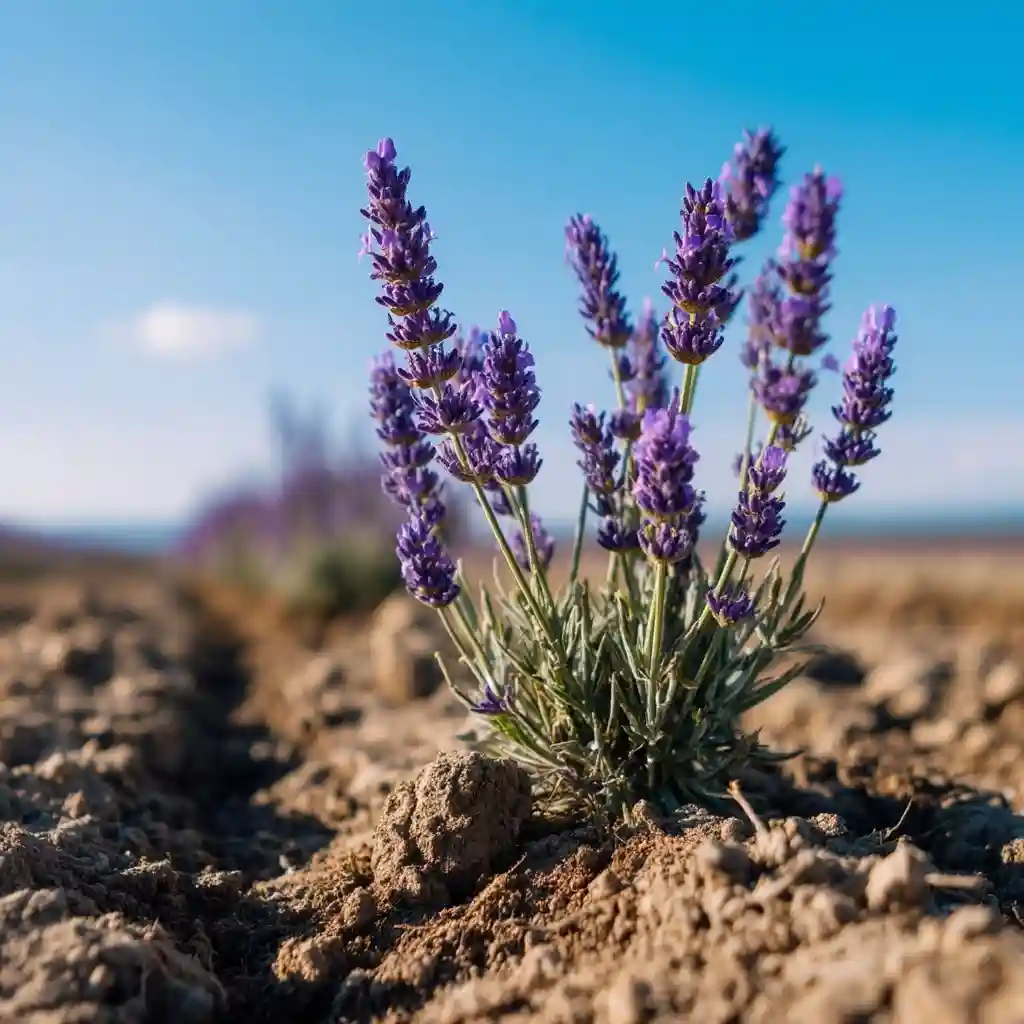
Caring for lavender properly is essential if you want to grow lavender successfully and enjoy long-lasting blooms. While it’s a low-maintenance plant, there are a few key factors that will keep your lavender thriving year after year.
☀️ Light Requirements
Lavender loves the sun. To promote strong growth and abundant flowers, place your plants in full sunlight, receiving at least 6 to 8 hours of direct light daily. Insufficient sun leads to fewer blooms and leggy, weak stems.
🌱 Soil Conditions
One of the most important rules in how to grow lavender is ensuring the soil drains well. Lavender hates “wet feet.” Use a gritty, sandy mix with a neutral to slightly alkaline pH. Avoid rich or heavy soils—they encourage foliage over flowers and increase the risk of root rot.
Pro tip: Mix in crushed limestone or garden lime to raise pH and mimic lavender’s native Mediterranean conditions.
💧 Watering
Newly planted lavender needs regular water during the first growing season to establish roots. After that, it’s extremely drought-tolerant.
- Water young plants once or twice a week until established.
- For mature plants, water only when the top 2 inches of soil are dry.
- In humid regions, water even less frequently to avoid fungal problems.
Overwatering is one of the most common mistakes. When in doubt, skip a watering.
🌡️ Temperature & Humidity
Lavender is hardy in USDA zones 5 through 9, but dampness, not cold, is usually the bigger threat. Protect your plants from high humidity by ensuring good air circulation and avoiding overcrowding.
In regions with humid summers, space plants 18 to 24 inches apart and avoid overhead watering.
🌾 Fertilizer
Lavender thrives in lean soil. Skip high-nitrogen fertilizers, which lead to excessive green growth with few blooms. Instead:
- Mix in a small amount of compost at planting time.
- Avoid routine feeding—this plant prefers to fend for itself.
🌸 Types of Lavender
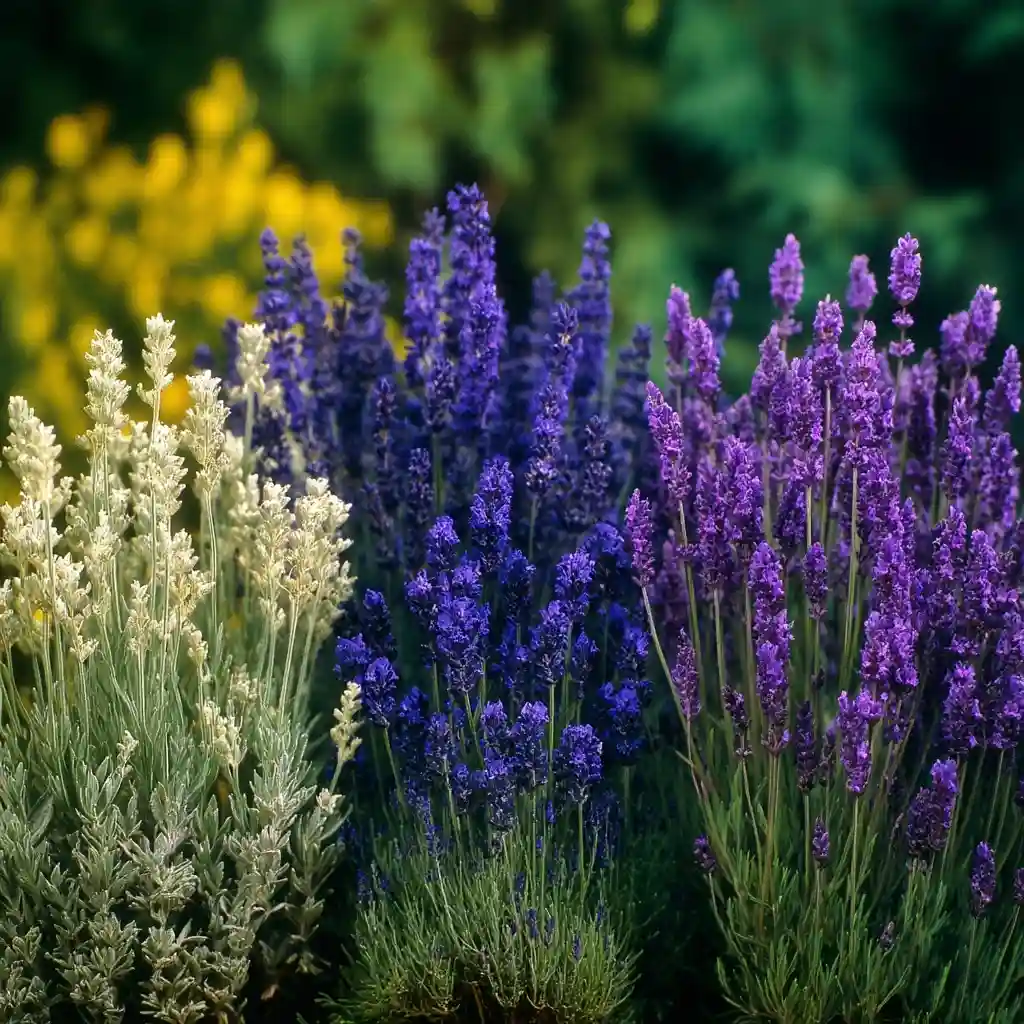
When learning how to grow lavender, it’s important to choose the right type for your climate and intended use. While all lavenders are beautiful and fragrant, different varieties offer unique growth habits, flower colors, and cold tolerance.
Here are the most popular and garden-friendly types of lavender:
1. English Lavender (Lavandula angustifolia)
- Best for: Cold climates (hardy to zone 5)
- Height: 1 to 3 feet
- Bloom Time: Early to mid-summer
- Fragrance: Strong and sweet; great for culinary uses
- Popular Cultivars:
- ‘Hidcote’ – Compact with deep purple blooms
- ‘Munstead’ – Hardy and early blooming
- ‘Jean Davis’ – Pale pink flower spikes
This is the most common variety and ideal for gardeners in temperate regions. English lavender also dries well and retains its scent.
2. Lavandin (Lavandula x intermedia)
- Best for: Larger landscapes or drying
- Height: 2 to 4 feet
- Bloom Time: Mid to late summer
- Fragrance: Very strong; ideal for potpourri or oil extraction
- Popular Cultivars:
- ‘Grosso’ – Highly fragrant and disease-resistant
- ‘Provence’ – Long-stemmed, perfect for bouquets
Lavandin is a hybrid between English and Portuguese lavender. It’s less cold-hardy (zone 6+), but offers more flowers and taller spikes.
3. French Lavender (Lavandula dentata)
- Best for: Warmer climates (zone 8+), containers, ornamental use
- Height: 2 to 3 feet
- Bloom Time: Spring through fall in mild regions
- Fragrance: Mildly sweet and pine-like
Its soft, serrated leaves and compact growth make it attractive in pots and borders, though it’s less fragrant than other types.
4. Spanish Lavender (Lavandula stoechas)
- Best for: Decorative gardens and pollinators
- Height: 1 to 2 feet
- Bloom Time: Spring and again in late summer
- Fragrance: Light and camphorous
- Notable Features: Distinctive “rabbit ears” on top of the blooms
While Spanish lavender isn’t ideal for culinary use, it adds flair and early-season color to gardens, especially in warmer zones (7+).
When choosing which lavender to plant, consider your growing zone, how you plan to use it, and how much space you have. Selecting the right type is one of the keys to how to grow lavender successfully.
✂️ Pruning
Pruning is essential for keeping your lavender healthy, productive, and looking its best. Without regular trimming, lavender can become woody, leggy, and less likely to bloom. Done correctly, pruning encourages fresh growth and fuller, more compact plants.
🗓️ When to Prune
- Major pruning: Late summer or early fall, after the final bloom.
- Light shaping: Early spring to remove winter damage and shape the plant.
Avoid pruning too late in the season (after mid-fall), as it can trigger tender new growth that’s vulnerable to frost.
✂️ How to Prune Lavender
The method depends on the type and age of your plant:
🪴 Young Plants (Year 1):
- Trim back by ⅓ after the first flush of blooms.
- Don’t cut into the woody base; focus on green growth.
🌿 Established Plants:
- Use clean, sharp shears.
- Cut back the plant by up to one-third of its height.
- Always leave a few inches of green growth above the woody base.
Never cut into old wood with no leaves—it may not regrow.
🌱 Lower-Growing Varieties:
- Lightly prune to shape the plant.
- Deadhead faded blooms to encourage more flowers.
🧹 Benefits of Pruning
- Encourages more blooms the following season
- Keeps the plant compact and bushy
- Prevents woody stems from taking over
- Improves airflow, reducing disease risk
Consistent pruning is one of the easiest ways to ensure success when figuring out how to grow lavender, especially if you’re aiming for long-term vigor and beauty.
✂️ Harvesting
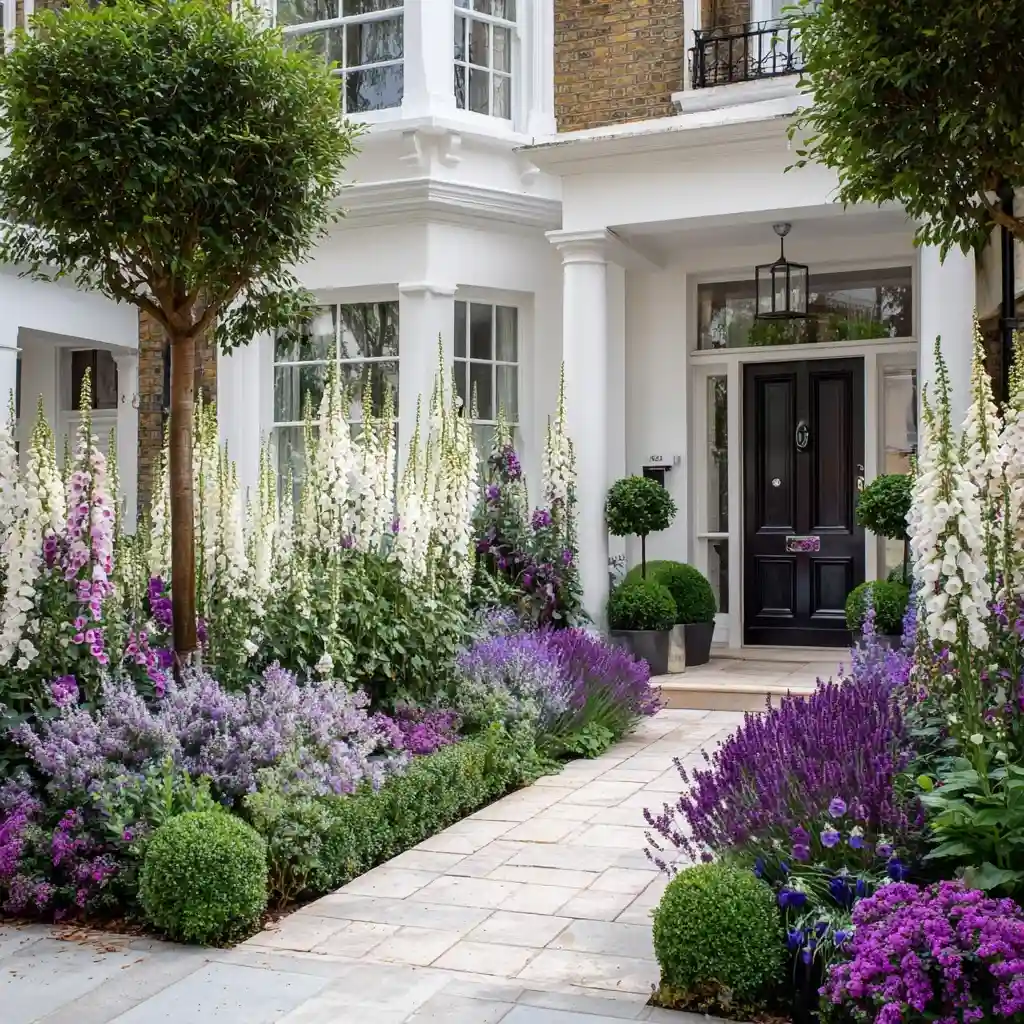
One of the joys of learning how to grow lavender is harvesting the fragrant flowers. Whether you plan to use them in crafts, cooking, or essential oils, timing and technique are key to preserving their color and scent.
🕰️ When to Harvest Lavender
- Harvest just as the buds begin to open, but before they’re fully in bloom.
- The ideal time is early morning, after dew has dried but before the sun is intense—this helps preserve the essential oils.
You can harvest throughout the blooming season, often twice per year with proper care and pruning.
✂️ How to Harvest
- Use clean, sharp shears or garden scissors.
- Cut stems about 2–3 inches above the woody part of the plant.
- Gather small bunches, tying them loosely with string or twine.
- Hang them upside-down in a dark, dry, well-ventilated space to dry fully. Drying usually takes 1–2 weeks.
If the stems snap instead of bend, your lavender is completely dried and ready for use.
🌿 What to Do With Harvested Lavender
Lavender retains its fragrance beautifully after drying. Here are some popular ways to use it:
- Sachets and potpourri for drawers or closets
- Herbal wreaths and bouquets
- Lavender oil or infused vinegar
- Culinary uses – add to cookies, teas, or seasoning blends
Proper harvesting not only provides you with useful flowers but also promotes healthier, bushier plants, reinforcing everything you’ve learned about how to grow lavender effectively.
🪻 Uses
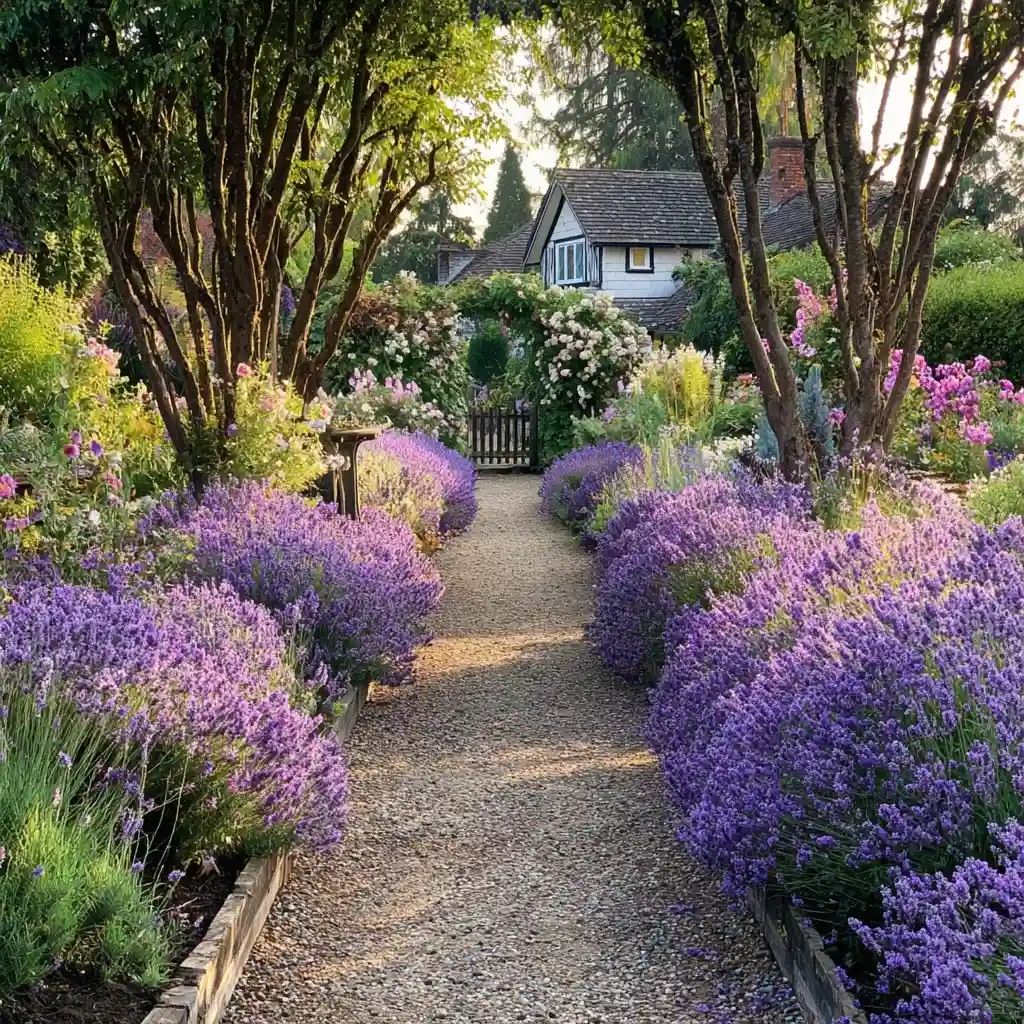
Once you’ve harvested your lavender, the possibilities are nearly endless. This versatile herb is valued not only for its beauty and fragrance but also for its culinary, medicinal, and practical applications.
Whether you grow one plant or a whole row, your lavender can serve many purposes throughout the year.
🏠 Around the Home
- Scented sachets – Tuck dried buds into small cloth bags to freshen drawers or closets.
- Homemade potpourri – Combine dried lavender with rose petals and citrus peel for a natural air freshener.
- Wreaths and arrangements – Add dried stems to seasonal wreaths or table centerpieces for rustic charm.
- Lavender water or room spray – Infuse dried lavender in distilled water for a calming, chemical-free scent.
🍽️ In the Kitchen
Lavender is edible in moderation and offers a subtle floral flavor. Always use culinary-grade lavender and avoid overuse, as its taste can be overpowering.
- Lavender tea – Steep dried buds in hot water for a relaxing herbal infusion.
- Lavender sugar or honey – Infuse sugar or honey with dried lavender for baking or tea.
- Lavender cookies, breads, or syrups – Add a small amount to baked goods or mix into lemonade for a unique twist.
- As a seasoning – Pair lavender with herbs like rosemary or thyme for savory meat rubs and marinades.
🐛 In the Garden
Lavender isn’t just useful after harvest—it plays an active role in your garden ecosystem too.
- Acts as a natural pest repellent – Helps deter mosquitoes, moths, and even deer.
- Attracts pollinators like bees and butterflies.
- Can be used in companion planting strategies (see next section).
🧘♀️ In Wellness
- Use dried lavender in bath salts for stress relief.
- Make essential oil at home (with proper distillation equipment).
- Known for its calming properties—helpful in aromatherapy and sleep aids.
Lavender’s beauty is only the beginning. Knowing how to grow lavender means having access to a multi-purpose plant that enhances your life inside and out.
🌿 Best Companion Plants for Lavender
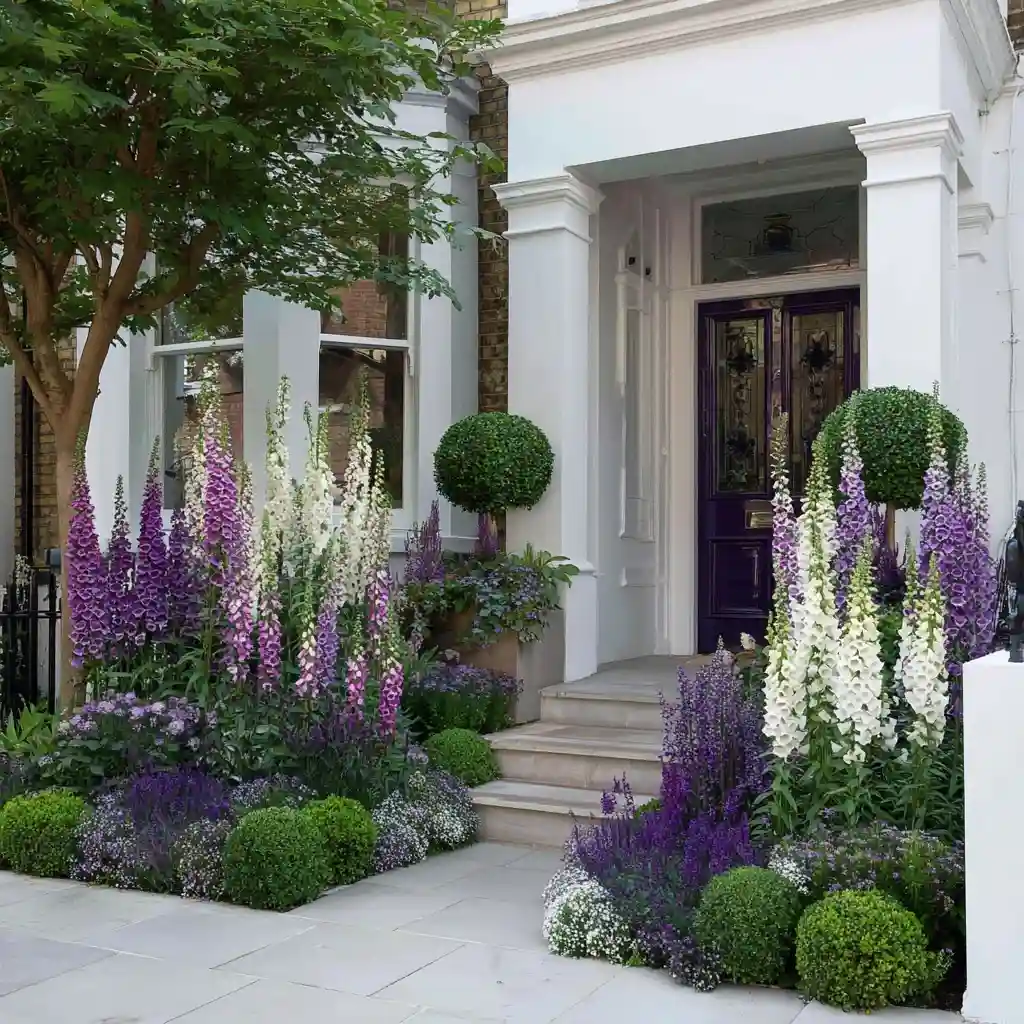
Lavender isn’t just a garden showstopper—it’s a valuable team player. When paired with the right plants, it helps deter pests, attract pollinators, and create visually stunning beds. Understanding companion planting makes your lavender garden not only more beautiful but also more productive.
🌼 Top Companion Plants for Lavender
Here are some of the best matches for lavender in both aesthetic and functional garden planning:
🪴 1. Rosemary
- Similar soil and sunlight needs
- Enhances pollinator activity
- Perfect for herb gardens
🌸 2. Coneflowers (Echinacea)
- Provide height contrast and summer blooms
- Attract bees and butterflies
- Thrive in full sun and well-drained soil
🌿 3. Thyme
- Low-growing, drought-tolerant
- Can act as living mulch
- Complements lavender in appearance and use
🍃 4. Sage
- Shares Mediterranean growing conditions
- Repels common pests
- Looks beautiful alongside lavender’s purple hues
🌹 5. Roses
- Lavender helps repel aphids from rose bushes
- Great color and texture contrast
- Best in mixed borders or cottage gardens
🌱 6. Oregano
- Another sun-loving herb with pest-repellent traits
- Makes a great aromatic border
- Works well in culinary gardens
🚫 Plants to Avoid Near Lavender
To grow lavender successfully, avoid pairing it with plants that prefer rich soil or constant moisture, like:
- Mint
- Hostas
- Ferns
- Impatiens
These companions can crowd or oversaturate your lavender, leading to poor health and reduced blooms.
By choosing the right neighbors, you not only improve lavender’s growth and health but also enhance the overall garden design. Companion planting is a smart step in mastering how to grow lavender efficiently.
🌱 Propagating Lavender

Propagating lavender allows you to expand your garden without buying new plants. It’s cost-effective, satisfying, and ensures consistency in your garden design by duplicating a plant you already love.
There are two main ways to propagate lavender: softwood cuttings and hardwood cuttings.
✂️ 1. Propagating from Softwood Cuttings (Spring)
This method is fast and ideal when lavender is actively growing.
How-To Steps:
- Choose a healthy stem with no flowers.
- Cut a 3–4 inch section just below a leaf node.
- Strip the lower leaves and dip the stem in rooting hormone.
- Insert into moist seed-starting mix or sand-perlite blend.
- Cover loosely with a plastic bag to retain humidity.
- Place in a warm spot with indirect light.
- After 3–6 weeks, when roots form, transplant to a larger pot.
🌳 2. Propagating from Hardwood Cuttings (Fall)
These take longer to root but are more durable.
- Take a 4–6 inch cutting from a woody stem.
- Follow the same basic process as above, but expect slower results.
- Rooting may take 6–10 weeks.
💡 Tips for Successful Propagation
- Always use sterile tools to avoid disease.
- Don’t overwater—lightly mist if needed.
- Once roots form, transition to full sun gradually.
- Harden off plants before planting them outdoors.
Propagation is one of the best ways to ensure a thriving lavender garden—and to share your plants with friends. Knowing how to grow lavender from cuttings gives you full control over your garden’s future.
🪴 Potting Lavender

Lavender grows beautifully in containers as long as you meet its basic needs—sun, drainage, and airflow. In fact, growing lavender in pots offers advantages: better control over soil conditions, easier overwintering, and flexibility in placement.
🏺 Choosing the Right Pot
- Use clay or terracotta pots, which help wick moisture from the soil.
- Ensure the pot has at least one large drainage hole—lavender hates soggy roots.
- Size the pot just slightly larger than the root ball (about 12–16 inches wide for mature plants).
🪵 Best Soil Mix for Potted Lavender
Lavender needs fast-draining, low-nutrient soil. For containers:
- Mix 2 parts potting soil
- 1 part coarse sand or perlite
- Optional: Add a bit of crushed limestone to boost alkalinity
Never use moisture-retaining soils—they hold too much water and promote root rot.
🌞 Placement & Light
- Place pots in a spot that receives 6–8 hours of full sun daily.
- If indoors, use a south-facing window or grow light to maintain blooms and fragrance.
💧 Watering & Fertilizing in Containers
- Water when the top 1–2 inches of soil are dry.
- Avoid frequent watering; lavender prefers to be on the dry side.
- No fertilizer is needed—compost at planting time is plenty.
Overwatering is the #1 cause of failure when growing lavender in pots.
🔄 When & How to Repot
Repot lavender every 2–3 years or when roots outgrow the container.
- Choose a pot 1 size larger
- Replace with fresh soil mix
- Trim back roots and foliage lightly to reduce stress
Potting lavender gives you great control over its environment, especially if your native soil or winter climate is less than ideal. It’s a perfect method to master while learning how to grow lavender in any setting.
❄️ Overwintering Lavender
Lavender is a hardy perennial in many regions, but how you care for it in winter can mean the difference between a thriving plant and one that doesn’t make it to spring. Cold, wet conditions are more dangerous than freezing temperatures, so winter prep is essential.
🏡 Outdoor Lavender (In-Ground)
Lavender planted in the ground can survive winter in USDA zones 5–9, but it benefits from a few precautions.
🌬️ Tips for Cold-Climate Gardeners:
- Stop pruning and fertilizing by mid-summer to help plants harden off.
- After the ground freezes, apply a 2–3 inch mulch layer (e.g., straw, shredded bark) to insulate the roots.
- Plant near a south-facing wall or stone surface to benefit from reflected heat and wind protection.
- Ensure excellent drainage—lavender that sits in soggy soil over winter often dies from root rot, not cold.
🪴 Potted Lavender (Outdoors or Indoors)
Lavender in containers is more vulnerable because its roots are exposed to fluctuating temperatures.
Option 1: Bring Indoors
- Place the pot in a cool, sunny room (like a sunroom or enclosed porch).
- Keep soil dry but not bone-dry—water just enough to prevent wilting.
- Avoid heated rooms; lavender needs winter dormancy.
Option 2: Overwinter Outdoors
- Place the pot in a sheltered location, such as against a foundation wall.
- Insulate the pot with bubble wrap, burlap, or mulch.
- Elevate the pot slightly off the ground to ensure drainage.
Potted lavender usually survives winter better if brought indoors in zones below 7.
Protecting your lavender during winter is just as important as planting it correctly. With a bit of prep, your plants will wake up strong in spring—ready to reward you with another season of blooms. It’s a vital part of mastering how to grow lavender year after year.
🐛 Pests & Diseases
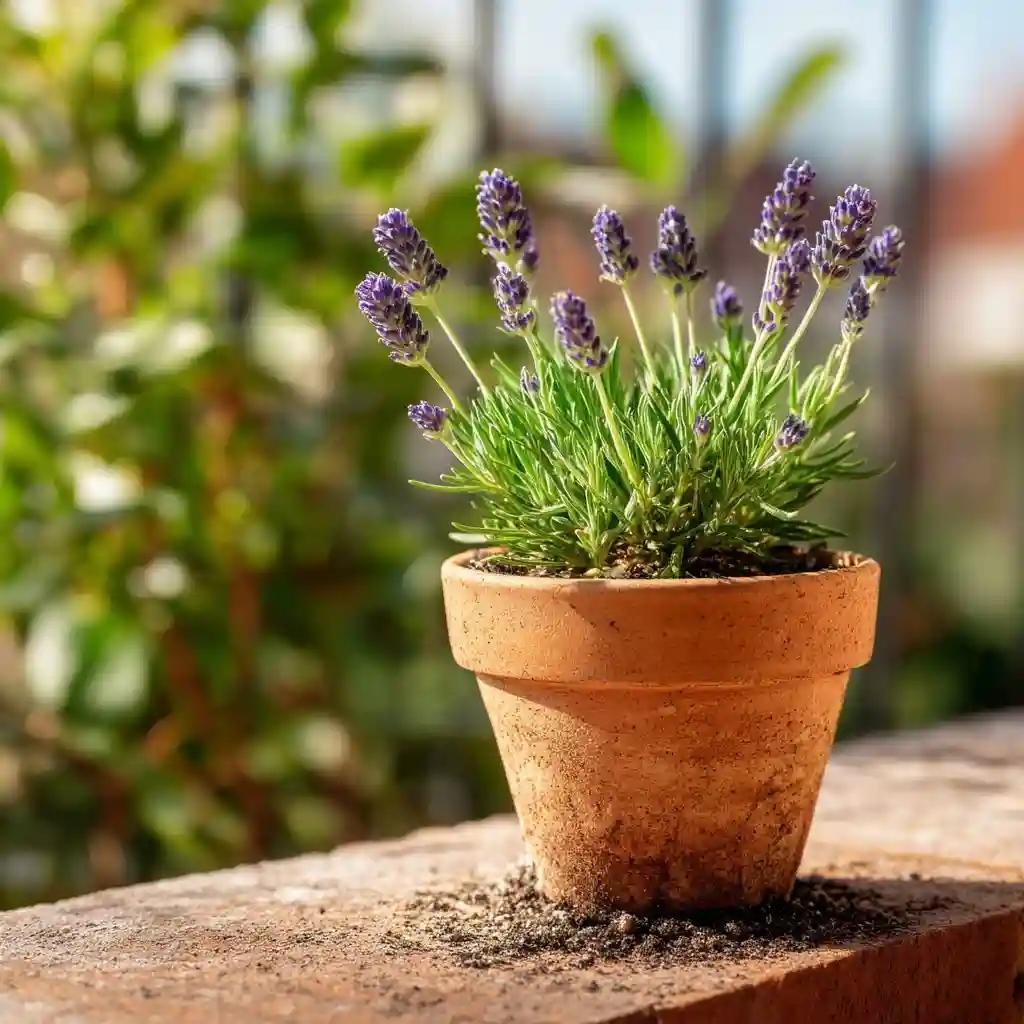
Lavender is known for being low-maintenance and pest-resistant, but it’s not immune. Poor conditions—especially overwatering and overcrowding—can lead to disease, while some pests are attracted to its fragrant foliage.
Here’s how to keep your lavender healthy and protected.
🐞 Common Pests
1. Whiteflies
- Tiny, white, flying insects that cluster under leaves.
- Suck sap, causing yellowing and leaf drop.
- Treatment: Spray with neem oil or insecticidal soap.
2. Spider Mites
- Look for fine webbing and stippled, yellowed leaves.
- Thrive in hot, dry indoor conditions.
- Treatment: Rinse with water, increase humidity, apply neem oil if needed.
3. Spittlebugs
- Leave behind foamy “spit” on stems.
- Usually harmless but unsightly.
- Treatment: Remove by hand or spray off with water.
4. Four-Lined Plant Bug (FLPB)
- Sucks on leaves, leaving small circular spots.
- Treatment: Pesticide or removal of damaged foliage.
🌿 Common Diseases
1. Root Rot (Phytophthora)
- Caused by soggy soil and poor drainage.
- Signs: Wilting, yellowing leaves, foul smell from roots.
- Solution: Remove affected plants, improve drainage, avoid overwatering.
2. Septoria Leaf Spot
- Fungal disease causing brown or black leaf spots.
- Thrives in wet, humid environments.
- Treatment: Remove infected leaves and use fungicide if necessary.
Prevention Tip: Space plants well for air circulation and plant in fast-draining soil. Avoid watering from overhead.
🦌 Bonus: Deer-Resistant!
Lavender’s strong fragrance is a natural deer deterrent, making it ideal for perimeter planting in gardens prone to wildlife damage.
While problems are rare, being proactive ensures a healthy, productive plant. Pest and disease control is one more reason why proper care is essential when mastering how to grow lavender.
💐 Bloom
Lavender’s iconic purple blooms are more than just beautiful — they’re fragrant, pollinator-friendly, and a key indicator of plant health. Understanding how and when lavender blooms helps you time your pruning, harvesting, and overall care strategy.
📅 When Does Lavender Bloom?
Most lavender varieties bloom from late spring through midsummer. However, bloom time can vary slightly based on the species:
- English Lavender (L. angustifolia): Blooms in early to mid-summer
- Lavandin (L. x intermedia): Blooms mid- to late summer
- Spanish and French Lavender: Can bloom as early as spring and multiple times per season in warmer climates
🔁 How to Encourage More Blooms
To maximize your flowers throughout the season:
- Ensure your plants get 6–8 hours of full sun daily
- Use well-draining, slightly alkaline soil
- Avoid rich, high-nitrogen fertilizers
- Deadhead faded blooms regularly to encourage a second flush
- Perform annual pruning after the last bloom to stimulate fresh, bushy growth
Pro Tip: Even if you’re happy with the plant’s shape, a light spring pruning will improve bloom performance significantly.
🌸 What Do Lavender Flowers Look and Smell Like?
- Lavender flowers grow in dense vertical spikes along the top of slender stems.
- Color ranges from deep violet to pale pink to white, depending on the variety.
- The scent is herbal, slightly sweet, and calming—a favorite for both people and pollinators.
Consistent blooming is a strong sign that your plant is thriving. Mastering lavender’s flowering habits is one more important piece in understanding how to grow lavender to its fullest potential.
⚠️ Common Issues
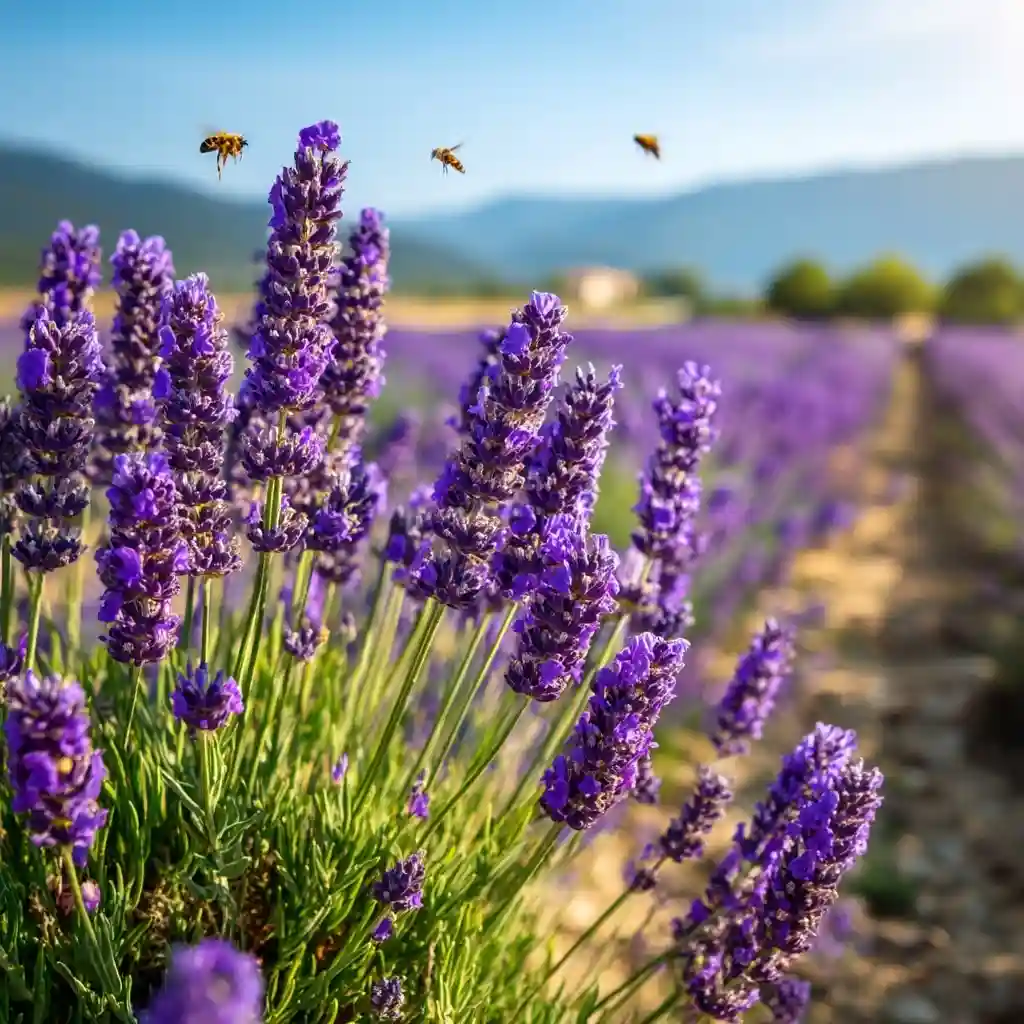
Even though lavender is hardy and low-maintenance, certain problems can pop up—especially if it’s overwatered, crowded, or neglected. Knowing what to look for can save your plant before it declines too far.
Here’s a breakdown of the most common lavender problems and how to fix them.
🍂 1. Yellowing Leaves
Likely Cause: Overwatering or poor drainage
- Yellow lower leaves often mean the roots are sitting in soggy soil.
- Lavender prefers dry feet—too much moisture leads to root rot.
Solution:
- Let the soil dry completely between waterings.
- Improve drainage with sand or gravel.
- Avoid mulching too heavily near the base.
😖 2. Drooping or Wilting
Likely Cause: Underwatering or root damage
- If the soil feels dry and the plant is drooping, it’s time to water.
- However, if it’s wilting in wet soil, the roots may be rotting.
Solution:
- Check moisture levels before watering.
- Repot or replant in dry, fast-draining soil if root rot is suspected.
🪵 3. Woody, Leggy Growth
Likely Cause: Lack of pruning
- Over time, lavender can become woody at the base, with sparse flowers.
- This affects both appearance and productivity.
Solution:
- Prune yearly after the final bloom, cutting back about one-third.
- Never prune into bare wood without green growth—it may not recover.
👃 4. Unpleasant Odor from Soil or Roots
Likely Cause: Root rot due to excessive moisture
- A sour or rotten smell is a red flag.
- Check for mushy or blackened roots.
Solution:
- Remove the plant from its pot, trim off rotted roots, and repot in dry soil.
- Let soil dry before rewatering, and reduce future watering frequency.
🪶 5. Lavender Not Blooming
Likely Causes:
- Not enough sun
- Overfertilizing (especially with nitrogen)
- Pruning too late or not at all
- Poor soil drainage
Solution:
- Move to a sunnier spot
- Stop fertilizing
- Adjust pruning schedule
- Improve soil texture and drainage
Solving these common issues is often just a matter of adjusting your routine. By staying alert to signs of stress, you’ll keep your plants healthy and enjoy better growth, making your efforts to learn how to grow lavender much more rewarding.
❓ FAQ: How to Grow Lavender
🌱 Does lavender come back every year?
Yes! Lavender is a perennial in USDA zones 5–9, meaning it will return each spring if properly cared for. Be sure to prune annually, protect the roots over winter, and avoid overwatering.
🪴 Can I grow lavender indoors?
You can, but it’s tricky. Lavender needs at least 6 hours of full sun daily and excellent air circulation. If growing indoors:
- Use a south-facing window
- Place in well-draining soil
- Avoid humid rooms like bathrooms or kitchens
🌸 Why isn’t my lavender blooming?
This is often due to:
- Not enough sunlight
- Too much fertilizer
- Lack of pruning
- Overly rich or poorly draining soil
Make sure your plant is in full sun, avoid feeding it, and prune yearly to stimulate blooms.
🌿 How much should I water lavender?
Water young plants weekly until established. Once mature, water only when the soil is dry 1–2 inches down. Overwatering is a common mistake—lavender prefers dry conditions.
💧 What kind of soil does lavender need?
Lavender thrives in sandy, well-draining soil with a pH of 6.5–7.5. Avoid heavy clay or overly fertile soils. If necessary, amend with sand, gravel, or lime to improve drainage and alkalinity.
🐝 Is lavender good for pollinators?
Absolutely. Lavender is a bee and butterfly magnet, making it a fantastic plant for pollinator gardens. It also helps repel pests like mosquitoes and deer.
🧼 Can I use lavender from my garden to make essential oil?
Yes, but making essential oil requires distillation equipment. For homemade use, you can infuse dried lavender in carrier oils (like almond or jojoba) to make calming body oils or sprays.
🌡️ Will lavender survive winter?
If you’re in zones 5–9, most varieties will survive winter outdoors with proper care. In colder zones, grow lavender in pots and bring it indoors or provide extra insulation outside.
Conclusion
Learning how to grow lavender is a rewarding journey for gardeners of all skill levels. With its resilience, beauty, and countless uses—from garden borders to herbal sachets—lavender earns its place in any sunny space.
By planting in well-draining soil, giving it full sun, pruning annually, and avoiding overwatering, you’ll enjoy lush blooms and fragrant stems year after year. Whether in the ground or in pots, lavender offers a low-maintenance way to add charm, pollinator appeal, and practicality to your garden.
🌿 Love gardening inspiration? Follow me on Pinterest for bold plant ideas, tips, and seasonal color!
More Posts
